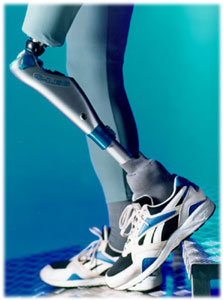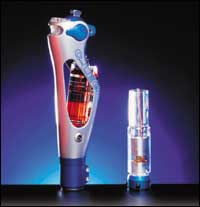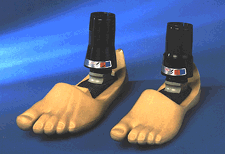Current State
Many have lost the use of their legs due to genetic disabilities, diseases, and physical trauma caused by accidents or war, losing their locomotion, the power of moving from place to place. But, since 484 B.C., human beings have been noted to fashion and use prosthetic limbs, artificial devices made to replace the missing parts of the body, and thus regain their ability to move. In fiction, we easily recognize the wooden peg leg Captain Ahab sports in the novel Moby Dick. But now, in the 21st Century, we can do so much better.
 There
are many companies designing prosthetic legs, even dividing and specializing
in one specific body part, such as prosthetic knees or prosthetic feet.
There
are many companies designing prosthetic legs, even dividing and specializing
in one specific body part, such as prosthetic knees or prosthetic feet.
- One such company, Cadence Technology, manufactures simply prosthetic knees. These knees are equipped with hydraulic knee controls that help to provide the user with natural "gait cycle."
- Ohio Willow Wood is not only a manufacturer of prosthetic limbs but is also a major research and development company for the development of its products.
- Sandia National Laboratories in New Mexico is participating in a project to develop a Smart Integrated Lower Limb (SILL). This project is funded through the DOE's Initiatives for Proliferation Prevention Program.
- Ossur manufactures the S-N-S - Swing and Stance Control knee mechanism - a hydraulic cylinder-piston system that has optimum swing resistance. Over 10,00 prosthetic knee control devices are modeled after the S-N-S's revolutionary design scheme.
- Otto Bock Health Care sells orthotic and prosthetic products, such as the famous C-Leg pictured to the left.
- Endolite has been helping amputees for over 100 years.
Future Direction
Despite the effectiveness of the current technological improvements in
assistive robotics currently, yet still many enhancements can be created.
enhancements can be created.
- Upgraded breaking systems.
- Amplification of position control.
- Triggers that allow person almost natural control over the joints whenever desired.
- More economic by utilizing different instruments, liquids, and triggers that may cut production costs.
- Using living tissue, preferably from animals, to construct a organic knee or ankle in place of the lost one.
Required Efforts
Improvements do not create simply create themselves. Therefore, there are certainly a number of efforts to be made that will further achievement of such goals.
- Lighter and versatile materials should be used in the construction of prosthetic limbs.
- A system that would help in the case of an unexpected situation. For example, a apparatus that could help the patient be able to recover his or her balance if required.
- Use of self-adjusting smart actuators that sense the pressure on them and react similar to human muscles.
Our Ideas
 We
feel that aim of prosthetic should not be narrowed only to the field of
assisting the disabled in reviving their lost mobility, yet, instead, be
attempting to aid patients into recovering the life they once had enjoyed or
give a new hope to those who have not yet experienced it. The quality of being
mobile is, "Capable of moving or of being moved readily from place to place."
We are convinced, that currently, even with the most advance mechanisms, true
mobility cannot be achieved with prosthetic limbs. Yet with progress that may
create a light, flexible, limb or joint that functions in unison with the
applicant, many physically strenuous activities may even one day be available
for the public good.
We
feel that aim of prosthetic should not be narrowed only to the field of
assisting the disabled in reviving their lost mobility, yet, instead, be
attempting to aid patients into recovering the life they once had enjoyed or
give a new hope to those who have not yet experienced it. The quality of being
mobile is, "Capable of moving or of being moved readily from place to place."
We are convinced, that currently, even with the most advance mechanisms, true
mobility cannot be achieved with prosthetic limbs. Yet with progress that may
create a light, flexible, limb or joint that functions in unison with the
applicant, many physically strenuous activities may even one day be available
for the public good.
We would like to put an on-board processor into the prosthetic. This processor would be used to gather data from sensors on the surface of the prosthetic and around the levers and and motors that make it move. This data would then be used to change the direction and force applied to the levers and motors. This processor could also receive owner input via wireless remote control, such as increasing the strength of the motion. This allows the owner to add to the sensory input to the prosthetic.
_____________________
Attribution: The images on this page come from the
Otto Bock Health Care
and Endolite web sites.